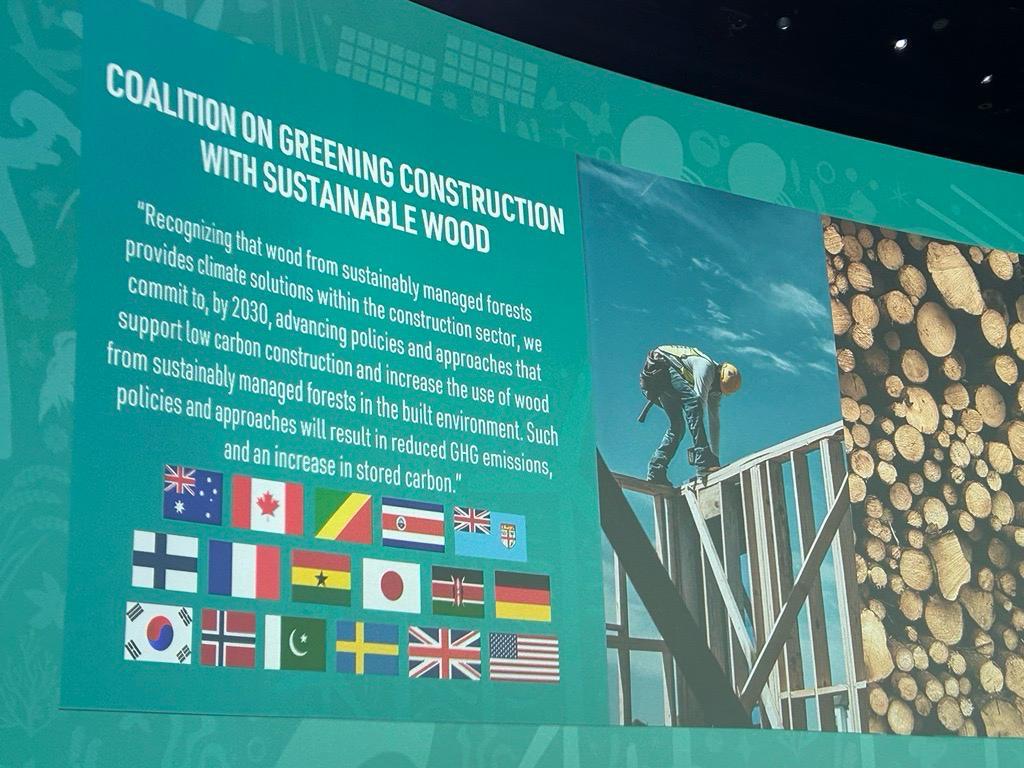06 December, 2023
Built by Nature commends Global Declaration supporting low-carbon construction
CEO Paul King Outlines Seven-Point Plan to Optimise Benefits of Timber and Biobased Materials.

AMSTERDAM December 6. Built by Nature is encouraged by and fully supportive of today’s declaration by a coalition of 17 countries to promote policies that support low-carbon construction and the increased use of wood from sustainably managed forests.
Announced today at COP 28, the signatory countries have endorsed the following statement:
Recognizing that wood from sustainably managed forests provides climate solutions within the construction sector, we commit to, by 2030, advancing policies and approaches that support low carbon construction and increase the use of wood from sustainably managed forests in the built environment. Such policies and approaches will result in reduced GHG emissions, and an increase in stored carbon.
The declaration has been signed by: Commonwealth of Australia, Canada, Republic of Congo, Republic of Costa Rica, Republic of Fiji, Republic of Finland, Republic of France, Federal Republic of Germany, Republic of Ghana, Japan, Republic of Kenya, Republic of Korea, Kingdom of Norway, Islamic Republic of Pakistan, Kingdom of Sweden, United Kingdom of Great Britain and Northern Ireland, United States of America.
Released under the sponsorship of the Forest and Climate Leaders’ Partnership (FCLP) and in close liaison with the Global Alliance for Buildings and Construction (GlobalABC), the coalition intends to work with non-government partners to responsibly accelerate action and scale up impact in the areas of:
-
Advancing public policies and enabling regulatory frameworks that support sustainable wood production and reduce barriers for wood in construction.
-
Supporting systemic collaboration and facilitate access to knowledge and support.
-
Mobilising finance and enhancing risk-taking capacity.
-
Engaging societies.

The breadth of the countries supporting the declaration has profound global implications for the built environment across both the global south and north. Built by Nature recognises that a diverse range of policy measures, design and construction methodologies, and technical knowledge will need to be deployed -- appropriate to each region’s level of urbanisation, market and value chain maturity, and access to biobased materials.
According to Built by Nature CEO Paul King:
“Construction timber from sustainably managed forests can be a highly cost-effective, natural carbon capture and storage technology if used in the right ways. We are also fully aware that the huge variation in geographies, urban development and economic realities across the signatory countries requires numerous different approaches to ensure the right outcomes for the climate, biodiversity and sustainable development.”
Mr. King added
“Built by Nature has both stimulated and compiled solutions to help unlock and raise awareness of the potential of timber and biobased materials, drawing mainly on the experience of our networks in Europe, but also through our global Prize.”
Built by Nature has outlined a seven-point plan to ensure realisation of the benefits of increasing the use of timber, as a holistic and genuinely sustainable solution:
-
The need for new buildings should be questioned as a precursor to any new development. Could the need be met in a different way, and/or could existing buildings be renovated, or extended using low-carbon materials instead? Demolition of existing buildings can be very expensive in carbon terms, given the likely embodied carbon in concrete and steel structures.
-
Where new buildings are needed, they should be constructed using very low-carbon materials including sustainably sourced timber and other natural, biobased materials. There needs to be a robust Life Cycle Assessment (LCA) methodology based on accurate data to enable ‘like for like’ comparison between different materials to inform the selection of the best, lowest embodied carbon options. There also needs to be an informed assessment of the comparative upstream impacts on biodiversity to enable a holistic understanding of relative impacts of different material choices on both climate and nature.
-
Construction timber should be sourced, where possible, from secondary, re-used wood. Virgin timber should only be harvested from sustainably managed forests, independently certified by credible bodies such as the Forest Stewardship Council (FSC) or PEFC whose standards should be regularly reviewed to ensure forest management delivers optimum benefits for nature, climate and local communities.
-
Long-term uses of wood such as construction should be prioritised and incentivised over short-term uses such as paper and packaging, or burning for energy production, which quickly release carbon emissions back into the atmosphere, to maximise its carbon storage potential.
-
Timber buildings should be designed for disassembly, to facilitate re-use of timber components in successive buildings at the end of an individual building’s life. Subsequently there should be a systematic cascade of uses of the timber (through the production of particle board, fibre board etc), to maximise its lifespan and the duration of carbon storage.
-
Timber for construction should be used in the most efficient ways through careful design and production techniques to minimise waste and optimise its use alongside traditional materials such as concrete and steel, and other bio-based materials with complementary applications such as insulation.
-
Accounting for carbon sequestered, substituted and stored needs to be done rigorously and transparently. This must ensure that ownership rights to claim stored carbon in buildings is clear and not double counted as could happen if credits have already been sold for carbon offsetting on the voluntary carbon market during initial forestry activities or included in governments’ national determined contributions (NDCs) under the Paris Agreement.
Paul King’s complete article “Seeing the Wood for the Trees” can be found here: Seeing the wood for the trees
